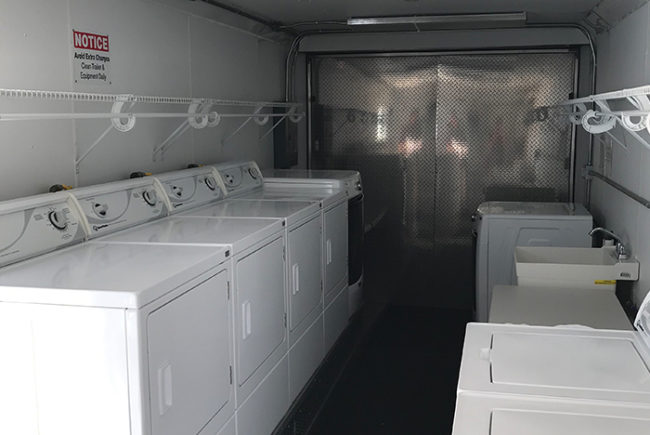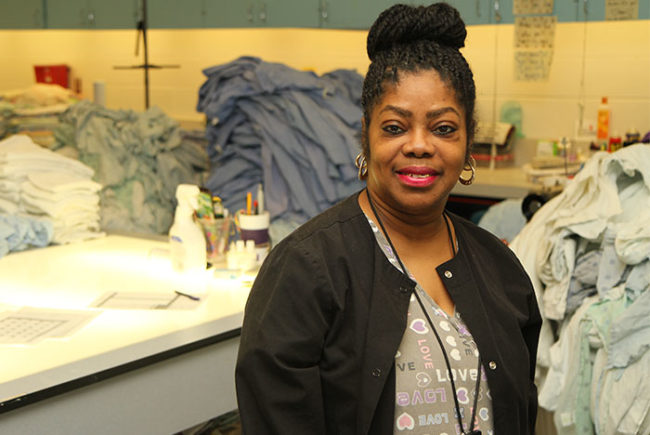 The fight against health care-associated infections (HAIs) among patients and staff has led hospitals to rethink how they maintain staff hand sanitation, how they clean surfaces and equipment in patient care areas,
The fight against health care-associated infections (HAIs) among patients and staff has led hospitals to rethink how they maintain staff hand sanitation, how they clean surfaces and equipment in patient care areas,
and even how they select interior finishes and patient-handling devices.
With all this attention to HAI prevention, it's not surprising that similar work has been going on with regard to the maintenance and cleaning of patient linens, textiles and staff uniforms.
Available guidelines
In 2006, a multidisciplinary group, known as the Healthcare Laundry Accreditation Council (HLAC), published a comprehensive performance Accreditation Standards for Processing Reusable Textiles for Use in Healthcare Facilities.
Although the HLAC has no regulatory ability, it requires that the facility undergo an initial inspection before being recognized as worthy of accreditation. After the initial inspection, the processor must pass a triennial inspection and pay a renewal fee to maintain that status.
Currently, the industry standard does not include either the quality of the detergents or disinfectant bleach to be used in processing. While some approved facilities may be using an "alternate" disinfectant type of product, the fact is that to this very date, there is no clinical data that indicates that any alternative to sodium hypochlorite (chlorine) bleach is comparable in its ability to inactivate bacteria.
Also frequently referenced are recommendations from the Centers for Disease Control and Prevention (CDC). A number of the items found in the CDC guidelines are similarly found in the occupational Safety and Health Administration's (OSHA's) Final Rule.
What OSHA says
Although issued almost 20 years ago with the emergence of the human immunodeficiency virus (HIV) era, the OSHA rules are still the only federal regulations with which every health care textile processor must comply. They were promulgated in OSHA's Final Standard on the Transmission of Bloodborne Pathogens.
In general, the focus and intent of the portion of the laundry section is to protect the health care worker from the hazards associated with exposure to potentially infectious materials during the collection, handling and sorting of contaminated textiles.
The requirement mandates the use of personal protective equipment (PPE), proper work practices, containment,labeling, hazard communication and ergonomics. The regulations also require that PPE be provided to those health care workers who may be exposed to contaminated laundry.
In addition to PPE, requirements involve training, sharps disposal, device accessibility and written institutional procedures to reduce risks of exposure. Although enforceable with the proviso that violators can be fined, the importance of the provisions is enhanced by the CDC guidelines that maintain that they be an integral part of the facility's overall infection control program.
Pertinent operational terms defined by OSHA include the following:
Bagging contaminated textiles. Once collected, items should be placed in bags that prevent leakage of fluids into the environment and contamination of the transporting personnel. Thus, the bags should be of sufficient quality to contain the wet contaminated items and prevent leakage during transport.
OSHA does not require special "biohazard" labeling of the laundry bags if universal precautions are used to handle soiled laundry.
If the hospital sends its laundry to an off-site facility to be processed (e.g., a commercial or co-op laundry), alternate labeling may also be used, provided the laundry facility employs universal precautions for all laundry.
Collecting contaminated textiles. Contaminated textiles should be bagged at the site of their generation and in a manner that minimizes agitation and prevents contamination of the environment and personnel.
Moreover, they should not be sorted nor prerinsed in patient care areas. Rather, they should only be bagged or contained at the point of use.
A policy should be established to determine when textiles should be sorted in the laundry facility.
Care should be taken before collection to ensure that all nontextile items are removed, including instruments, needles or plastic single-use underpads. Items of this nature present the greatest risk of transmitting bloodborne infections.
There is also a need to be on the lookout for a variety of the patient's personal items, such as dentures, eyeglasses and hearing aids.
Contamination. This is the presence of blood or other potentially infectious materials (OPIM) on an item or surface.
Contaminated laundry. This means laundry that has been contaminated with blood or OPIMs, or may contain sharps. If the presence of blood or other potentially infectious materials is reasonably anticipated, the textile product is considered contaminated.
Decontamination. This is the use of physical or chemical means, such as sodium hypochlorite (chlorine) bleach, to remove, inactivate or destroy bloodborne pathogens on a surface or disinfecting an item to the point where it is no longer capable of transmitting infectious particles and the surface or item is rendered safe for handling, use or disposal.
Exposure control plan. The employer must establish an operational plan designed to eliminate or minimize employee exposure.
PPE. This is specialized clothing or equipment worn by an employee for protection against a hazard. General work clothes (e.g., uniforms, pants, shirts or blouses) not intended to function as protection against a hazard are not considered to be PPE. Where there is occupational exposure, the employer shall provide and maintain, at no cost to the employee, appropriate PPE such as gloves, gowns, laboratory coats, face shields or masks, and eye protection.
Soiled. Compared with a textile that is contaminated, "soiled" describes a textile that has been used or worn and soiled by perspiration, body oils or one of the many other items to which it may have been exposed.
Sorting. All personnel involved in the sorting and washing of contaminated health care textiles should be appropriately trained, have adequate access to hand-washing facilities, use PPE and be supervised to ensure compliance with protective procedures.
Training personnel. Employees with occupational exposure are required to participate in a training program that is conducted by a knowledgeable individual, provided at no cost and held during working hours.
 |
| Employees feeding textiles through folders at a health care laundry facility. |
This training should be provided at the time of the initial assignment and at least annually thereafter. Appropriate training records must be kept for three years. Training should include information on the proper use of PPE (e.g., when and how to don, when and how to remove) and the location of containers where items are to be placed for either disposal or laundering.
The training should cover procedures for identifying, bagging, handling and transporting contaminated laundry. Training should also include information on how to handle and dispose of sharps and other biohazardous materials that might have inadvertently been left in the textiles while being collected.
Not to be overlooked is the need for all employees to be trained in proper hand-washing techniques and frequency.
Transporting textiles. Once contained, bags can be transported from their point of collection to the laundry
or to another designated holding area by handcart or chute.
The use of chutes is often complicated by design problems including mechanical obstruction by overfilled bags. In addition, there have been concerns because of the piston action of textiles transported vertically, potentially discharging ground-level contamination to upper floors and patient care areas.
If the bagged items are transported in carts with cloth liners, the liners and bags should be washed daily. Because there is no known length of time that bagged textiles can be stored before washing, reasonable schedules should be developed for transport and processing.
Universal precautions. This is an approach to infection control that considers all textile products sent to the laundry to be contaminated. Under these circumstances, it is not necessary to identify the bags in which the textiles are transported in any special manner because they will all be handled and laundered the same way.
Crucial connection
Preventing HAIs among staff and patients is a top priority at all hospitals. Proper cleaning and handling of laundry is easily as important as the more widely discussed methods of HAI control. The advice above will help health facilities professionals stay on top of this very crucial infection connection.
Nathan L. Belkin is author of the "Laundry, Patient Linens, Textiles and Uniforms" chapter of the Association for Professionals in Infection Control and Epidemiology's (APIC's) Text of Infection Control and Epidemiology (3rd revised edition), 2009, Washington, D.C., from which this article is excerpted and edited. He is the author of more than 100 articles and has consulted with a variety of health care organizations including APIC and the Association of Perioperative Registered Nurses (AORN).
| Sidebar - Understanding hospital laundering |
| The first chemical formulation for textiles used in health care was published in 1938. It established the need for wash water to be 165 degrees Fahrenheit and include a dosage of chlorine bleach for heavily soiled items. With the passing Subsequently came the introduction of polyester-cotton blend fabrics, which were said to require low-temperature formulations (120 to 140 degrees Fahrenheit) if they were to provide the benefit of their "no-iron" attribute. The results of a study published in 1975 demonstrated that reductions in the bacterial count were attainable at temperatures as low as 100 degrees Fahrenheit, but this required an increase in the amount of chlorine bleach used in the process. Following are a couple major considerations: The disinfectant. In today's environment of super bugs, the disinfectant is often the most important chemical used in the laundering process. Its use in disinfecting a broad spectrum of microorganisms on inanimate surfaces in the patient's environment (i.e., door handles, blood pressure cuffs, overbed tables and computer keyboards) is well established. Other remote "vehicles" cited in the clinical literature are physicians' stethoscopes, pagers, and toys in a pediatric oncology floor. Even bed-making has been implicated. For those textile items that must be sterilized before use, such as surgical gowns and drapes, disinfection is particularly critical. The sterilization process is designed to destroy all forms of microbial life but that has its limitations. In particular, its effectiveness is contingent upon the bioburden with which it is challenged (i.e., the amount and type of biological contamination on or in an object and the number of organisms that need to be inactivated by the sterilizing process). Home laundering. There has been a trend to replace the traditional type of uniform hospitals provide to their ancillary personnel with those worn by surgical personnel (commonly called "scrubs"). Other than personal protective equipment (PPE), there is no scientific data supporting the need for or regulations requiring health care employers to provide such uniforms for infection prevention reasons. Similarly, there is no study suggesting that home laundering (versus institutional-type laundering) poses any increased risk of infection transmission. The only clothing (scrubs or otherwise) worn by workers that the Occupational Safety and Health Administration (OSHA) holds employers responsible for laundering are those used for PPE. OSHA maintains that if a pullover-type scrub becomes minimally contaminated, the employee should be trained to remove the garment in such a way that avoids contact with the outer surface (e.g., rolling up the garment as it is pulled toward the head for removal). However, if the amount of blood exposure is such that blood penetrates the garment and contaminates the inner surface, it may be prudent to train employees to cut the contaminated scrub to aid removal and prevent exposure to the face. Some facilities have made special arrangements to launder and process employee-owned contaminated clothing in specially designated locations with appropriately trained staff. Others have installed a washer and dryer in a designated area and developed a mechanism for a "uniform exchange" so that employees are provided with temporary uniforms while their own garments are being laundered. Although the Centers for Disease Control and Prevention (CDC) describes the matter as unresolved, the Association of Perioperative Registered Nurses (AORN) has historically opposed the practice of permitting surgical personnel to launder "soiled" scrubs at home. The major difference in the positions taken by these two organizations obviously accounts for the differences in positions taken by some health care providers and the infection control community. However, AORN has recently acknowledged that many hospitals have been permitting their surgical personnel to launder their own "soiled" attire at home. In so doing, they have suggested the manner for laundering and included the proviso that the process include the use of chlorine bleach. The practice appears to be clinically effective and to have no harmful effect on the home environment. Not one of the hospitals that have implemented this type of program is known to have experienced an increase in the incident of surgical-site infections. One can only conclude that policies requiring that soiled scrubs be processed by a "facility-approved and monitored" laundry is not evidence based. Advances in chemical technology and new innovative types of processing equipment have made laundering a science within itself and should not be taken lightly. |





